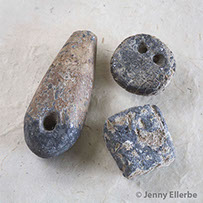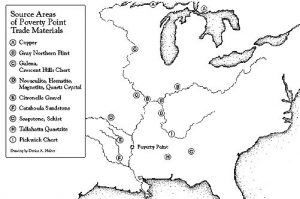The Poverty Point archaeological site in northeastern Louisiana is most widely known for its massive earthen mounds measuring up to 72 feet tall and forming six concentric semicircles. At its height from 1200 BCE to 700 BCE, the Poverty Point Native American site had an estimated population of around 5,000 and its advanced architecture and tools indicate a thriving society. Not only is Poverty Point an architectural wonder, it also serves as an indicator of a widespread trading network throughout the Midwest and Northeast. Stones and artifacts from as far as 1000 miles have been found by archeologists at Poverty Point.
When archeologists first began observing large amounts of stone artifacts at Poverty Point, they were able to identify the key element in many of the artifacts as galena, a shiny silver form of lead (II) sulfide. By 1970, over 700 artifacts containing galena had been identified at Poverty Point and four smaller surrounding settlements. The most common galena artifacts are bird effigy pendants, oval pendants, beads, and polished rectangles.

Galena has been found in a wide range of artifacts at Poverty Point including pendants, beads, polished rectangles and stones. Archeologists believe that these artifacts were often used for ceremonial and decorative purposes at Poverty Point as well as other Native American sites throughout the Southeast.
Archeologists used trace element analysis, the process of identifying elements present in small amounts, in order to trace a material back to its source of origin. Trace element analysis of galena artifacts at Poverty Point indicated that the majority of the rocks originated from the Potosi deposit in Missouri while others were from the upper Mississippi valley. Archeologists also conducted trace element analysis of galena artifacts at seven other Native American sites and found that 55% of the artifacts could be traced to the Potosi deposit and 34% to the upper Mississippi valley while the other 11% was inconclusive. Because of this evidence, archeologists were able to identify a trading pattern that used the Mississippi River, the Ohio River and the Arkansas River as well as the Ouachita stream and stopped at sites including Yazoo Basin and a Native American settlement at Calion.

Galena was by no means the only material traded at Poverty Point. This map shows the source areas for other minerals found at Poverty Point in addition to the two main galena source points which are marked as A and C on this map.
Archeologists have also noted a highly similar style of bird pendants made from galena in four different locations along the Mississippi and Ohio Rivers indicate that galena was traded both as a raw material and as a finished product. This exhibits the shared cultural importance of galena while also indicating variations in cultural traditions.
Additionally, this trade is especially interesting to archeologists as it does not follow the theory of fall off analysis which states that the quantity of a material will decrease with the distance from the source of that material. There are many more galena artifacts at the Poverty Point site in Louisiana than there are at sites closer to the Potosi deposit. This indicates that the trade was not simply a reciprocal exchange, but rather a more complicated directional trading pattern. The Poverty Point trading network is one of the first instances of large scale long distance trade in the Americas that can be fully shown by archeologists. It represents an extremely important development in society as well as social organization.
Additional Readings:
Feasting at Poverty Point
Trace Element Analysis on Pottery from Oaxaca
References
Hays, Christopher T, Richard A Weinstein, and James B Stoltman
2016 Poverty Point Objects Reconsidered. Southeastern Archeology
Hill, Mark A, Diana M Greenlee, and Hector Neff
2016 Assessing the provenance of Poverty Point copper. Journal of Archaeological Science 6: 351–360
Louisiana Division of Archaeology
2014 Discover Archaeology. Louisiana Department of Culture, Recreation and Tourism
Walthall, John A, Clarence H Webb, Stephen H Stow, and Sharon I Goad
1982 Galena Analysis and Poverty Point Trade. Midcontinental Journal of Archaeology 7: 133–148
Image Citations:
Material Source Map. Louisiana Archaeology Project
https://www.crt.state.la.us/dataprojects/archaeology/virtualbooks/POVERPOI/trade.htm
Galena Artifacts. Louisiana Division of Archaeology
https://www.crt.state.la.us/dataprojects/archaeology/povertypoint/ceremonial-life.html

Nice summary of the literature on this site/trading network. What does the article suggest this stone meant more symbolically to those who used it? If it doesn’t follow the processual theory of fall off, which would have that there would be more artifacts closer to their source, how can we account for this? Is the theory itself wonky, or is there some type of religious/spiritual meaning that could explain this unidirectional movement of things from Potosi. Do the authors mention anything like this?
According to John Walthall and colleagues in their article “Galena Analysis and Poverty Point Trade,” galena artifacts were most frequently used in spiritual or religious ceremonies due to the lustrous quality of the galena. This luster lead to the belief that galena artifacts were somewhat “unearthly” and could help further a connection with spirits. Overtime, galena artifacts became ingrained in ceremonies in the Poverty Point culture. In terms of the fall off theory, Walthall also mentions in the same article that relatively large population at Poverty Point as well as its geographical location near rivers could account for this. Additionally, the theory of fall off analysis fails to take into account cultural differences between sites as galena was ingrained in the culture of Poverty Point in ways that it may not have been at other locations that were geographically closer to the source.